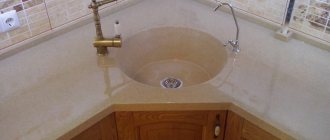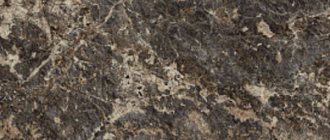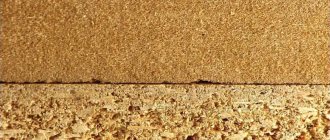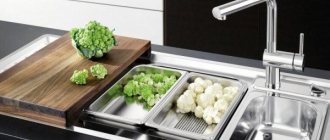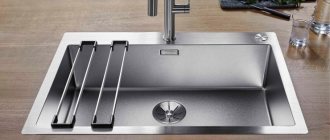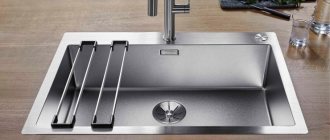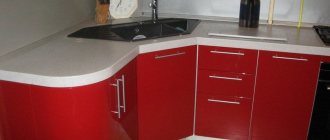How to choose Kitchen sinks
The sink is one of the central elements of any kitchen. Most people do not consider washing dishes one of their favorite activities. By choosing a convenient kitchen sink, you can greatly facilitate and simplify this process.
When purchasing, a whole range of different factors are taken into account - the size of the kitchen, the surrounding interior, the number of residents, etc.
A high-quality sink is not only attractive in appearance, but also functional. It is important to choose a model that will fit into the interior, be comfortable to use and last a long time.
Kinds
The construction market offers dozens of sink options, ranging from appearance, manufacturing materials, modifications, to suit every taste and budget.
The shape of the bowl is:
- round;
- oval;
- trapezoidal;
- square;
- rectangular.
Based on the installation method, they are divided into the following models:
- invoices;
- mortise;
- integrated;
- under-table.
Based on the material used, the following types of kitchen sinks are distinguished:
- stainless steel;
- ceramic (enamel);
- from natural and artificial stone.
Criterias of choice
It is advisable to purchase a sink at the stage of planning the design of the kitchen unit. Decisive factors for the right choice:
- Modification. The sink can be corner or straight, with one or several bowls, with or without a wing.
- Colors. It is desirable that the color of the sink matches the shade of the countertop and fits harmoniously into the overall design of the kitchen.
- Shape and capacity of the bowl. If you have to wash dishes frequently, including tall pots, the sink should be deep.
- Installation method. Built-in, integrated sinks are designed for the countertop. For an isolated cabinet with a sink, an overhead option is suitable.
- Price. If your budget is limited, you can purchase a stainless steel or ceramic sink. When price does not matter, models made from expensive raw materials or with additional accessories are suitable.
Double mortise sink Stylo 2B (Teka)
One of the popular European manufacturers Teka (Spain) offers the consumer a double mortise sink Stylo 2B made of stainless steel (chrome 18/nickel 10) of a rectangular shape, the coating of which is polished. Ideal for placement on a sink cabinet 80 cm wide (no less).
The size of the bowls of the Teka Stylo 2B sink is 36 x41.7 x 17 cm, and the overall dimensions of the sink itself (WxDxH) are 82.8 x 48.5 x 17 cm. The sink is designed in such a way that there is a drain hole with a 3 ½” basket valve . In addition, the kit includes a siphon.
Material of manufacture
The service life, appearance of the kitchen sink, price, variety of models and other characteristics depend on this indicator. Let's take a closer look at the different options.
Stainless steel
Such bowls are made from chromium-nickel alloy. They fit well into kitchens of different design styles. The surface can be smooth, glossy or matte, rough. The latter option is less susceptible to scratches, but costs a little more.
Advantages of a stainless steel sink:
- affordable price;
- wide selection of models and sizes;
- durability;
- light weight;
- easy cleaning;
- corrosion resistance.
Minuses:
- when a stream of water touches the bottom, a loud noise is created;
- There is only one color option;
- appearance of scratches on the surface.
The stainless steel kitchen sink is made from a single sheet of metal, without welds. The thickness of the material also matters: from 0.12 to 3 mm. The higher this indicator, the stronger the sink and the more expensive the price.
Expert opinion
Olga Kovalenko
Since 2010 I have been engaged in interior design and architectural design.
To check that the sink is really made of stainless steel, just attach a magnet to the surface.
Ceramic (enamel)
The basis of the product is earthenware or porcelain, or metal, cast iron. The top enamel coating is hard and smooth, does not scratch and is not susceptible to chemical influences or temperature changes. These sinks are available in different shades and fit harmoniously into rustic and retro interiors.
Pros of ceramic sinks:
- scratch resistance;
- hygiene;
- ease of care.
Minuses:
- short service life;
- fragility of the top coating.
Made from artificial stone
These models are made from granite, marble chips, quartz sand, acrylic resins, a mixture of minerals and polymers. Their surface looks presentable, looks like natural stone, and has good performance characteristics.
This type of kitchen sinks has been popular in recent years, thanks to its stylish design, it fits into interiors of different styles.
Advantages of artificial stone sinks:
- affordable price;
- no noise from the water jet;
- variety of models and colors;
- easy care;
- impact resistance.
Minuses:
- formation of indelible stains;
- The use of abrasive cleaning agents is prohibited.
Made from natural stone
These are expensive luxury models that look presentable and are usually used in luxury interior designs. Products are made by hand from marble, onyx, basalt, granite, travertine. Often, a kitchen sink made of stone is a single composition with a countertop.
Pros of a stone sink:
- has a unique pattern;
- strength and durability.
Minuses:
- high price;
- complexity of installation;
- coloring matter “eats” into the surface and can only be removed by sanding;
- This bowl requires delicate care.
How to choose an artificial stone sink
Artificial stone is a serious competitor to stainless steel.
Peculiarities
They are distinguished by excellent performance indicators, aesthetically pleasing, pleasant to the touch, easy to maintain, and have good noise absorption. Artificial stone is a composite material consisting of a filler and a binding polymer. The filler is natural minerals, and polymer resins are used for the connection in a ratio of 80% natural stone and 20% polymer binders. In addition, dyes and pigments are introduced into the mass.
Kitchen sink Schock Quadro
Inexpensive sinks are sometimes coated with gelcoat, which makes the surface smooth and free of pores. This coating allows you to preserve the appearance for a long time. Modern casting technologies make it possible to obtain a huge number of different variations of colors, shades and textures. Since the product is injection molded, it can be given any shape. In general, the range of products made from composites is wider than those made from stainless steel. They are easy to care for and are not afraid of household chemicals. The low porosity of the surface does not allow it to absorb dirt and grease - all this can be easily removed with soapy water and a sponge.
Designs, shapes and depths
From a practicality point of view, the larger and wider the bowl, the better. However, there is not always enough space on the countertop to install such sinks. Experts recommend installing the sink in such a way that there is at least 5 cm from the outer border to the wall. The permissible depth is from 16 to 26 cm.
It is important to decide in advance on the mixer model. For a shallow bowl, you need a high tap, otherwise it will be problematic to slide the pan under the running water.
The shape of the bowl plays a special role in practicality. Round and oval sinks are stylish, but they have a harder time holding as many dishes as square and rectangular ones. Trapezoid-shaped sinks are installed in the corner of the kitchen unit. For non-standard design ideas, asymmetric models are chosen.
The design of sinks may vary:
- one or two wings (platforms for placing dishes);
- additional bowls (same volume or smaller);
- extended rim for mixer tap with round hole.
Types of surfaces
Currently, kitchen sinks with three types of surface .
- Polished - they are quite vulnerable, but at the same time have a spectacular appearance;
- Matte - they are characterized by practicality. Scratches and salt deposits appearing on the surface of these products are invisible.
- Corrugated - the main convenience is that they prevent splashing of water droplets.
Individual sinks can combine several types of surfaces. It is quite convenient if the inside has a matte corrugated surface, and the outside is polished, which has a spectacular look.
Dimensions
Compact sinks have dimensions from 45x45 cm. Large standard sinks are 60x100 cm. You can also make custom-made sinks of various sizes and modifications.
As a rule, the larger the volume of the bowl, the wider the wings for drying dishes. In small kitchens, compact round or square sinks are often installed, but deep. When calculating the space for a future sink, its external boundaries are taken into account.
Corner models help save space, but before installing such a sink, you should make sure that you don’t have to stretch or bend too much when washing dishes.
When choosing a sink, it is important to consider the size of the cabinet located under the bowl. Its dimensions should be such that the sink can be installed in the middle, within the boundaries of the vertical walls.
Additional items and accessories
For operation, you should choose a sink with auxiliary elements, such as:
- tap for a separate bowl;
- automatic valve;
- filters for water purification;
- overhead grilles.
These devices make the everyday process of preparing dishes, washing dishes and food easier, and help save countertop space. For expensive models, manufacturers add accessories designed for a specific model and color.
Expert opinion
Olga Kovalenko
Since 2010 I have been engaged in interior design and architectural design.
Typically you have to purchase a sink faucet separately, but its design must match the sink. So, a metal faucet is suitable for stainless steel, and for stone - with a similar decorative coating. Chrome faucets are considered universal and can be combined with different materials.
Installation methods
The sink should be selected not only based on the design of the kitchen unit, the size and modification of the cabinets, but also on the installation method.
There are sinks:
- Mortise. The bowl is lowered into a pre-cut hole of a suitable size. The upper parts are sides, wings are placed on the tabletop.
- Integrated. They are usually made together with a set and installed flush, flush with the tabletop and visually forming a solid structure.
- Invoices. These sinks cover the top of a small cabinet. Suitable for modular, free-standing models. Most often they are made of stainless steel.
- Under-table. Models to order. Such a sink is rarely installed in the kitchen, in exclusive designs made of stone. Such bowls are usually installed below the level of the countertop.
Price
The price of a kitchen sink consists of several components, but the type of raw materials used is decisive. However, high cost is not always an indicator of durability or quality.
Thus, the usual stainless steel can last longer than a stone sink, but cost an order of magnitude less. You have to overpay for a stylish appearance, configuration, additional accessories, and the reputation of the manufacturer.
The price range for a sink made from a certain material can vary significantly. Thus, budget stainless steel in the construction market costs no more than 2 thousand rubles, and in an elite plumbing showroom it costs 30-50 thousand.
Products can be arranged in the following order in ascending order of average prices:
- ceramic – 1-3 thousand rubles;
- stainless steel – 2-6 thousand rubles;
- made of artificial stone – 4-10 thousand rubles;
- from natural – from 30 thousand rubles.
No. 4. Steel thickness
The thickness of the steel determines the quality of the finished sink. The thicker the material, the better the product will cope with shock loads, withstand the weight of heavy dishes and make less noise when it comes into contact with drops of water. Steel that is too thin will vibrate violently when the water jet hits it and may even bend under pans filled with water. There are cases when thin stainless steel was even pierced with a knife, but we are talking about handicrafts.
The thickness of the steel sheet ranges from 0.4 to 1.2 mm , while stamped sinks are always thinner than welded ones. In any case, it is not recommended to use a sink with a thickness of less than 0.6 mm . In the case of welded products, this parameter increases to 1 mm.
Quality Manufacturers
Well-known brands of plumbing fixtures produce beautiful, functional and high-quality products. Their products have a 1-3 year warranty and a service life of up to 20 years. Such sinks are usually sold in stores. The markets often offer products made in China, the quality of which meets minimum standards.
Popular international brands:
- Longran;
- Villeroy&Boch;
- TEKA;
- Blanco;
- Reginox;
- Ukinox;
- Smeg;
- Foster;
- shock;
- Florentina;
- Alveus;
- Franke;
- Polygran and others.
Main problems
When installed correctly and in compliance with standards, kitchen sinks retain their decent appearance and performance properties for a long time.
However, some consumers encounter problems:
- Swelling of the countertop next to the sink. Caused by improper installation and insufficient waterproofing. Occurs when moisture penetrates into the cut.
- The appearance of scratches and stains. More often observed on stainless steel and artificial stone during intensive use.
- The sink is unstable. Caused by the lack of sealing tape in the areas adjacent to the countertop.
- Noise when in contact with a stream of water. Caused by vibrations of the thin steel bottom. Some consumers stick a rubber base on the bottom to solve the problem.
- Indelible stains and plaque. To prevent this problem, it is necessary to regularly clean the surface of the bowl using suitable household chemicals.
When planning to choose a kitchen sink that will delight the owners for a long time, you need to take into account a set of characteristics: appearance, service life, functionality. After all, a practical and aesthetic sink should not only decorate the room, but also last for decades without loss of quality.
What should a built-in sink look like in a kitchen?
To choose the best washing option, you need to decide what specific requirements it must meet.
- The capacity must be appropriate, since not only cups and plates, but also pots, pans and other kitchen utensils can be washed in it.
- Do not forget that the sink is constantly subject to changes in water temperature, as well as the influence of all kinds of household chemicals. At the same time, it is important to preserve its original appearance for as long as possible. To do this, you should install a high-quality sink.
- Depending on the overall style of the kitchen space, the appropriate sink model is selected. This allows you to adhere to a single stylistic decision, and all items in the kitchen are harmoniously combined with each other.
- The culinary preferences of all family members are taken into account. This determines the frequency of use of the sink, as well as the main list of frequently used products;
- In parallel with installing the sink, you should consider installing the cleaning system and filter. It is necessary to analyze the location of other household appliances near the sink.
